Anna Danes was a lifelong runner, jogger and walker, but after giving birth to her daughter 12 years ago, she got busy and wasn’t able to keep up her regular exercise routine. She quickly noticed changes in her body, especially her weight beginning to creep up, and eventually went back to a cardio-heavy routine.
She wasn’t seeing results, though, and after successfully battling breast cancer, getting divorced and shaking off her old life as a lawyer to become a jazz singer (her sophomore album, “Find Your Wings,” topped iTunes’ jazz chart in 2016), she knew it was time for a change.
“I’m not ready to look midlife, even though I am midlife,” says the 47-year-old musician. “I’ve got a new life post-divorce: dating and a new career that’s taking off.”
So just three weeks ago she began lifting weights four times a week, and has already noticed major changes.
Aside from losing 8 pounds — no small feat! — Danes says, “My energy is way up too — old running speeds are now a breeze.”
While every body requires a different workout routine, and the exercise regimen that works best for you may involve all cardio or very little, fitness experts say that a mix of cardio and weight training can be important not only for aesthetic reasons but also to help prevent injuries and decrease the risk of osteoporosis, particularly in women.
“I think the most important thing about any athletic pursuit for women ... is the general sense of competence you get from knowing that your body can do whatever you need it to,” says Karen Ko, a Toronto-based strength coach and personal trainer. “This is huge for women. We’re socialized to defer to men in areas of physical activity — they are the experts, they are inherently stronger than us. Strength training challenges this narrative and is extremely empowering.”
While some women, especially those facing illnesses or injuries that impede their ability to perform load-bearing exercise, do best with cardio only, most would benefit from adding some kind of weight training to their workout routine. Ko says it’s never too late to start, and adds that the “bro culture” of the weight room is changing and becoming more welcoming to people of all genders.
Need a little inspiration? Let the journeys of Danes and the other women below motivate you to try something new.
“I feel in control more, that I can do this, I can get fit on my own just by doing the work — and feel strong!”

Name: Anna Danes
Age: 47
Location: Solana Beach, California
Cardio history: I’ve been a runner/jogger/walker the majority of my life. In my early 30s, I did a lot of running races but stopped after I became a mom at 35. Then, my cardio routine depended on what I could get done while tending to a little kid. As my daughter got older, I returned to the gym sporadically and sometimes had trainers help me (but that could never last because of the expense factor). My very recent routine, before I began lifting, was jogging on the treadmill at the recommended “fat burn” rate about two times a week, and walking briskly outdoors about five times a week for about 4 miles each time.
Why she switched: Three weeks ago, after Mother’s Day, I stepped on the scale and was mortified by what I saw. Suddenly, over the past year, I had put on 15 pounds of pudge and was starting to look midlife and out of shape, despite my best efforts to do cardio almost every day.
What she does now: I lift weights about four times a week for roughly an hour, with the help of an app on my smart phone called FitBod. The app keeps track of all your goals and stats, keeps track of your workouts and varies them daily according to muscle groups that need to be worked. I try to hit upper and lower body at least twice a week.
In addition to lifting, I’ve decided to take my cardio to the next level with the help of another free app, Running. Instead of jogging with no results, the app helps you use interval training, get motivational build-up from the app’s “coach” and streams upbeat music.
How her body has reacted: Besides losing 8 pounds (which I couldn’t do before for the life of me with just jogging) in just three weeks, I’ve noticed I am starting to look cut again. There is definition in my abs and arms, which I’ve not seen in a long time. I feel tight, and my skin feels better all over, has better texture. I’ve also increased my normal running speed on the treadmill from 4.2 to 5.5 miles per hour in just three weeks. I feel stronger all over, and can run up and down the stairs in my house just doing chores!
I feel 100 percent better about my outlook on life, too. I feel in control more, that I can do this, I can get fit on my own just by doing the work — and feel strong! The new positive outlook is probably the most important thing for me.
“People always ask me if I’m a runner and I respond, ‘No I’m a squatter.’”
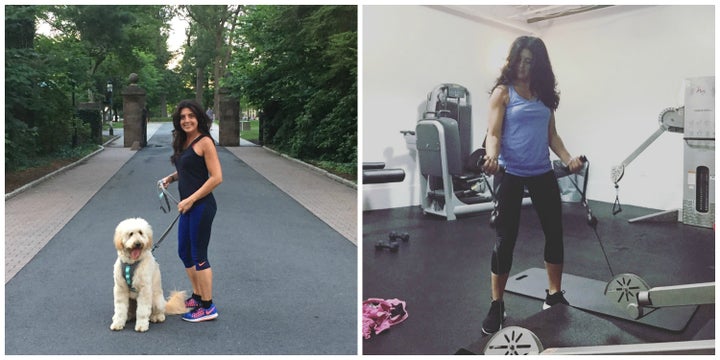
Name: Christie Maruka
Age: 47
Location: Wall, New Jersey
Cardio history: I was always in the gym with a 30- to 40-minute cardo session, four or five days a week, either the elliptical or stairs. My workout included weight training all my body parts, except I didn’t do squats and dead lifts. I did abs every other day, longer cardio sessions and higher reps with weights.
Why she switched: I switched because I started seeing and reading a lot more about women doing squats and dead-lifting, and they weren’t huge or extremely bulky, and I became very interested in trying this. Then I found Instagrammer Jen Selter (queen of squats) and admired her figure, so I followed her and began doing squats and absolutely loved the results I was seeing. As I get older, or any woman in their 40s, we will start losing muscle and I want to prevent this as much as possible. Squatting and dead-lifting have given my legs and butt a lot of shape and muscle definition.
What she does now: My routine now consists of higher-intensity weight training, no more than 12 reps. I split it up into upper body and lower body, and use the maximum amount of weight I can lift. I do exercises that have big, compound movements and involve the biggest muscles — like your quads, hamstrings and glutes. My cardio I do at a higher intensity and not longer than 25 minutes, and only on the days I do my upper body. After squats and dead lifts, I can barely walk out of the gym, so no cardio.
How her body has reacted: I’ve noticed that I’m so much stronger, I have more energy and I’m less tired. My body fat is lower and I’m much leaner, and you can really see the muscles. Wearing dresses and skirts in the summer and feeling confident is when it all pays off. I love my routine and I love the results. I am constantly preaching to friends and clients about squatting and dead-lifting and how great it is. People always ask me if I’m a runner and I respond, “No I’m a squatter.” It takes dedication and, for me, working out is a way of life, not a temporary fix.
“It’s so utterly empowering, no feeling can match that.”
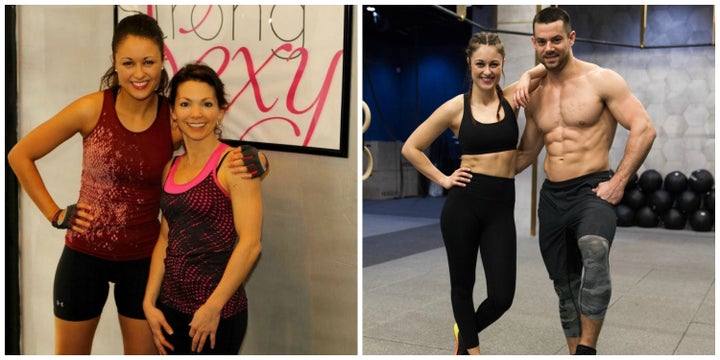
Name: Diana Mitrea
Age: 29
Location: New York City
Cardio history: I have been active the majority of my life, but unfortunately, the majority of my life was spent doing only cardio. As a kid and in high school, I played soccer and swam. In college, I would run on the treadmill or outside every so often.
Why she switched: After graduating, I started teaching group fitness programs but all of them were around cardio ― my favorite class to teach was kickboxing. I would jump around the room for 60 minutes with my participants, drenched in sweat. It was amazing and tons of fun, but I felt that after a few years, my fitness had plateaued. I wasn’t getting leaner or more toned. I also felt like I wasn’t “powerful” enough in front of the class. Some of my other instructor colleagues really were a presence in front of the room. You looked at them and you thought, “Wow, that person is STRONG.” I wanted to be like that.
What she does now: I signed up with a personal trainer to help me learn more about weightlifting and strength training. Sometimes I think people don’t realize the value of having someone holding you accountable and helping you with form, education and motivation. I was determined enough to make the change that I went and purchased several months’ worth of sessions and committed to it. Little did I know that I would fall in love with how lifting made me feel.
Fast forward to now and I’m incredibly proud of where I’ve gotten in the past few years. I’m a personal trainer and group fitness instructor in NYC. I went from zero strength to being able to dead-lift over 200 pounds, doing several pullups in a row, and can clean and jerk almost my body weight. [Editor’s note: “Clean and jerk” refers to a weightlifting movement in which the barbell is pulled up to chest and shoulder height and then hoisted above the head.] I tell every woman I meet to stop being shy and get in that weight room! If you don’t know where to begin, hire someone. You will never realize what your body is truly capable of until you start picking up real weights.
How her body has reacted: The main difference I notice is that people compliment me not only on my physique (lifting weights really helps out your booty!), but people are also impressed with what I can do. It’s more than just my appearance that gives them a positive impression. It’s so utterly empowering, no feeling can match that. The other bonus is that I don’t have to work out as often to maintain my fitness. I used to put in two or more cardio hours a day! Now if I miss a day or two, it doesn’t even matter. I can eat more. My body can burn the food as fuel just by standing there. It’s amazing to me how it all works.
The only thing I wish in all this is that I had started lifting sooner. I would be so much stronger now if I had started five years earlier! However, starting now is better than never so I’m glad I discovered this world when I did.
“I never think about needing to be smaller or looking like a fashion model because I need my muscles to perform.”
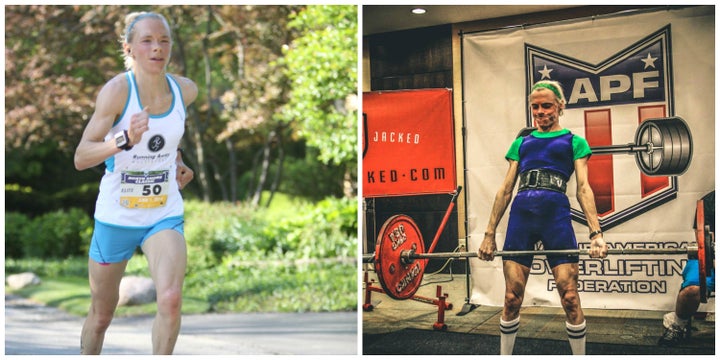
Name: Meghan Kennihan
Age: 35
Location: La Grange, Illinois
Cardio history: I started long-distance running in 2008, half and full marathons, which led to half and full Ironmans from 2011 to 2013. That moved to ultramarathons — 50 km, 50-miler, 100 km, etc. — for the past three years. During these periods, I was basically doing cardio in the form of biking, running or swimming for 15 to 20-plus hours a week, with maybe five of those hours as light circuit-style, high-rep weight training — so more cardio than lifting.
Why she switched: I made the switch to more heavy lifting and dedicated powerlifting because I was always injured. I would get at least two injuries a year that would knock me out for two months, many of them stress fractures. So I knew I needed to build stronger bones, hips and glutes to support my endurance activities, and the light weightlifting wasn’t cutting it. A CrossFit gym near my house was starting an eight-week powerlifting class that was going to provide a program and culminate in a competition. It was great to have the support and coaching for the proper form. I ended up adapting quickly and falling in love with the heavy lifts and the powerlifting program. I broke six Illinois state records at the competition and was hooked. I also did not get injured that year.
What she does now: I still compete in ultra runs and endurance activities, but I do only three to four days a week of running and low mileage. I do the powerlifting twice a week and mix in other cross-training activities, like kettlebells, TRX and yoga, to keep my body guessing and make sure I am a well-rounded athlete.
How her body has reacted: I feel strong and confident. I am a personal trainer and run coach and it is great when I can challenge my male clients to lifts and put them in their place! I never think about needing to be smaller or looking like a fashion model because I need my muscles to perform.
“If there was a zombie apocalypse, I think I’d be able to survive!”

Name: Nicole Quiroz
Age: 33
Location: San Diego
Cardio history: I wouldn’t consider myself an avid runner, but it was my top-choice workout before I discovered lifting. I would run on treadmills or trails around a lake or hillsides, do some kind of kettlebell workout, followed by whatever diet fad I was on at the moment. One thing was clear to me: I wasn’t getting any results. Sure, running made me sweat like a maniac and gasp for air every second. But I was also injured quite often. I would consistently hurt my hips, knees and ankles.
Why she switched: Tearing my hip muscle was the worst out of all of my injuries and the final straw. It took me almost four months to recover from my injury. I knew I had to start working out again, but I didn’t want to return to running. That’s when a friend introduced me to powerlifting and it changed my life.
What she does now: Now, about 90 percent of my workout is powerlifting. I would start with stretches or yoga, followed by 10 sets of dead lifts and 10 sets of back squats. That’s it! I feel like lifting is the best cardio workout anyone can get. I can burn up to 650 calories in an hour just by lifting weights.
How her body has reacted: The strength and confidence I’ve gained through powerlifting has changed my life and my perspective on fitness. There’s a stigma about women and powerlifting — the fear of gaining bulk. No, you will not bulk unless you have a strict meal plan that purposefully makes you bulk. You will gain definition and curves, which is what I believe many women who work out strive for. In addition, I’ve revisited running. I’ve noticed that I’m not tired as quickly. I also run faster and can run a longer distance without stopping. The fat I’ve lost and the muscle and strength I’ve gained through powerlifting have helped support my running milestones. If there was a zombie apocalypse, I think I’d be able to survive!
“I just wanted more of a body. I’m a petite woman with no curves, which can be daunting in today’s booty-obsessed world.”
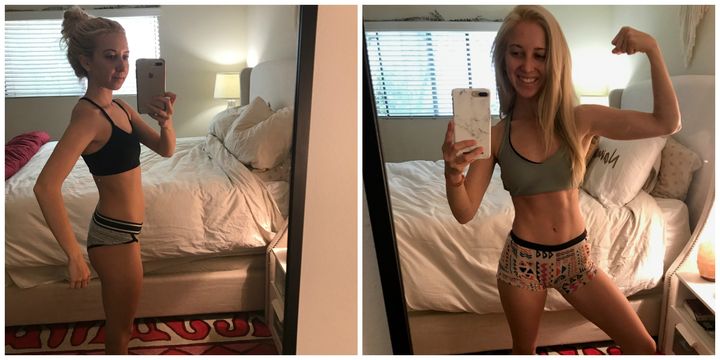
Name: Jenay Rose
Age: 27
Location: Los Angeles
Cardio history: I could never really get into working out. I was never athletic growing up, but about three years ago I fell in love with yoga. Vinyasa flow is a fast-paced, constantly moving practice.
Why she switched: As I’ve become a more advanced practitioner of yoga (I am now a yoga teacher and wellness influencer), I have been craving more. I used to leave a level 3, two-hour yoga class exhausted, but now I am ready for more. I also wanted a more drastic improvement in muscle mass. I have always been fairly thin and petite, but as I get older, I desire to have more of a physique. So, I decided to add in weightlifting about three or four weeks ago.
What she does now: I attend three or four yoga classes a week, and train in the gym at least twice a week, but I am going to up that to four times a week. Once you start seeing small results, it can be incredibly gratifying and inspiring to work harder, commit more and really accomplish your goals.
How her body has reacted: Since adding in weights, I feel leaner and stronger — physically and mentally. Yoga is incredibly soothing and replenishing for me, but I wasn’t 100 percent happy with my physical appearance. I just wanted more of a body. I’m a petite woman with no curves, which can be daunting in today’s booty-obsessed world. Overall, sweating and detoxifying through working out has made me a happier, kinder and all-around better person. I now have the ability to channel my angst into something positive, benefiting myself and everyone around me. Lifting weights makes me feel like a strong, independent woman, while yoga gives me peace of mind and confidence.
“My attitude doing it is not very good. But afterward, I feel really good.”
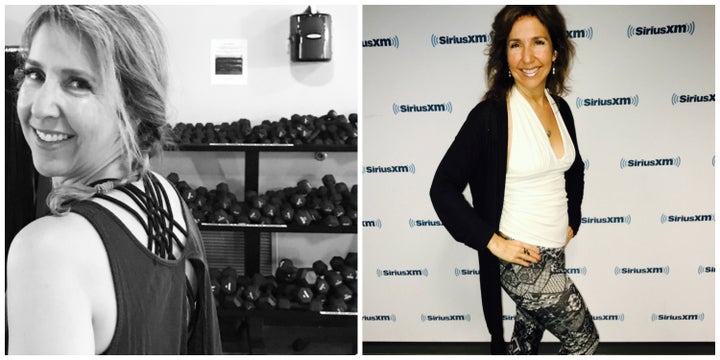
Name: Jacquie Jordan
Age: 46
Location: Los Angeles
Cardio history: My workout routine before lifting was pretty consistent: swimming Monday, Wednesday and Friday; spinning Tuesday and Thursday; yoga Saturday; yoga sculpt Sunday. I would also substitute yoga sculpt with jogging or hiking.
Why she switched: I switched because some parts of my body — no matter what — were not changing or improving. I eat clean. I don’t eat sugar, flour or drink alcohol. I’m practically no-carb. So I know food is not an issue.
What she does now: I’m really new to the weightlifting, and I love/hate it. I hate it because it is so foreign to me, and I have all sorts of preconceived ideas about who should really be doing weightlifting. Since it’s new to me, and I’m already experiencing a significant shift in the body in terms of inches, I have cut back on my other workouts. I’m doing hot yoga to stretch out and continuing with the swimming.
How her body has reacted: I generally carry weight around my hips and thighs; I seem to be predisposed this way, and the weightlifting is literally cutting through the fat. I am being trained by Kenneth Rippetoe of One with the Water. This is all foreign to me and I have tremendous resistance. My attitude doing it is not very good. But afterward, I feel really good.
“I’m positive that my physical fitness helped me have a faster and (somewhat) easier delivery of my son in 2016.”
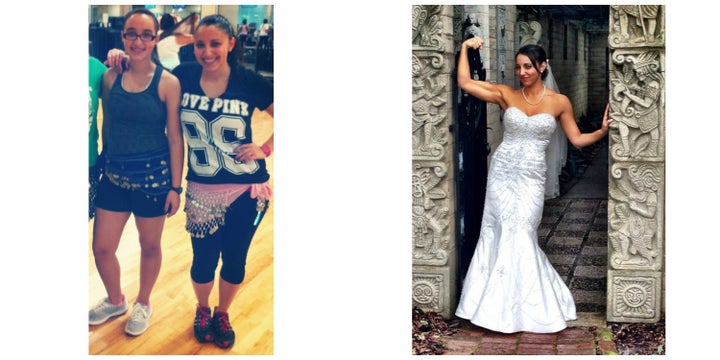
Name: Alayna Curry
Age: 29
Location: Orlando, Florida
Cardio history: In college, I gained more than the typical “freshman 15.” Once I graduated, I was fed up with being insecure about my body. I decided to try Zumba since I liked dancing and wasn’t a big fan of other fitness activities. I fell in love! I went two to three times a week at first. Once I started to feel better about working out, I started doing cycle classes, too. I’d say at that time, I was doing about four to five cardio classes a week. Eventually, I decided to get licensed in both Zumba and cycle and started teaching a few classes a week. I was still intimidated by weightlifting, so I kept to cardio because I was seeing weight loss.
Why she switched: One day, I overheard another instructor say, “If you’re trying to lose weight, you need to incorporate weights into your workout routine, not just cardio.” That was the first time I’d really heard that. After a while of just cardio, I hit a plateau and didn’t really see any changes in my body, so I decided to start lifting. The biggest motivator for me was having a lifting buddy who was also just starting out, so we could keep each other accountable.
What she does now: Now I spend more time on weights than cardio. Your body actually works harder and longer during and after weightlifting than cardio, so you get a bigger bang for your buck. As a working mom, it’s hard to find time to get to the gym, but I make an effort to lift three to four times a week. I focus on different areas each day — legs, back and biceps, triceps and chest, and shoulders. I try to incorporate a short abs workout into every session, too. I never do the same workout routine twice. I want my body to be surprised, and challenge my muscles in a different way each week. I do a mix of machines, free weights and body weight exercises. In addition to lifting, I still do cardio about two to three times a week. I’ve been teaching Zumba for six years and I love it. I’m able to burn upward of 750 calories a class. I also walk a lot with my family.
How her body has reacted: Once I started lifting, I got a lot of feedback from friends saying I’d lost weight. Funny thing is, I didn’t really lose any pounds, I was just looking leaner and fitter. Now that I’ve been lifting regularly for several years, my energy is better and I feel stronger. I’m positive that my physical fitness helped me have a faster and (somewhat) easier delivery of my son in 2016. I continued to lift responsibly through my pregnancy, which helped me quickly get back into pre-pregnancy shape later. Overall, I feel better and look better thanks to this lifestyle change.
“I was always self-conscious of having big thighs, now I embrace them because they are strong thighs. These thighs let me squat a lot of weight!”
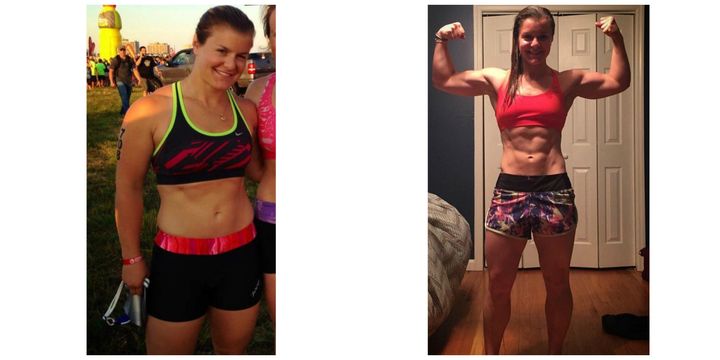
Name: Meghan Scanlon
Age: 29
Location: Boston
Cardio history: Before I started lifting, I did many endurance events. Once I stopped playing soccer in college, I began to run and completed 10 marathons, including qualifying for and running the Boston Marathon. Running eventually led to triathlons, including three full Ironmans. During this time, I was running five days a week, anywhere from 5 to 20 miles, biking three to five days between 60 minutes and three hours, and swimming three days for about an hour.
Why she switched: I decided to truly switch my focus after the summer of 2016 due to a hip injury while training for a marathon. I could perform most lifts without pain, yet couldn’t run a mile. This is when I saw a shift in my body, energy and success lifting. I entered my first powerlifting competition the winter of 2016. After the second time I competed, I ran a personal-record half-marathon the next weekend.
What she does now: I lift five days a week. Four specifically for powerlifting, and one day I leave for fun. The length of my workouts varies depending on where I am in my training cycle, but ranges between an hour and two most days. I also do high-intensity interval training once a week and run twice, but only 2 to 4 miles each time.
How her body has reacted: Since making the switch, my body composition has changed drastically. It is something I didn’t notice right away and I truly still don’t understand how drastically it has changed until I look at pictures and see how much leaner my body is and how much stronger I am. I have more energy outside of training, which leaves me in a good mental space to focus on eating healthfully to fuel my body properly.
While I was training for endurance events ... at times I felt run down, and it would be hard to eat properly and I would end up bingeing. I also was in the constant mindset of needing to be thinner to excel in endurance events, which would lead me to eat too few calories and again I would end up bingeing. So although my calorie burn was much higher while training for marathons and Ironmans, my nutrition was not nearly as good. The other thing that has changed is my confidence. I was always self-conscious of having big thighs, now I embrace them because they are strong thighs. These thighs let me squat a lot of weight! It is funny, I am even more confident in my running (short distances, of course!) and have run a lifetime mile personal record this year. I am so much more confident in my own skin, which transfers to all aspects of my life.
Looking for resources to help on your weightlifting journey? Personal trainer Ko recommends Girls Gone Strong, Starting Strength and Stronger by Science to help you get started and train smart.
The responses in this post have been edited for clarity and length.
